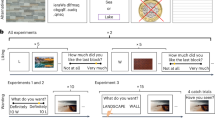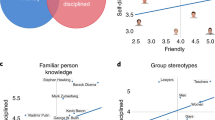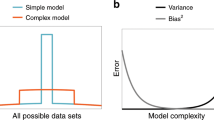Abstract
Humans learn about people and objects through positive and negative experiences, yet they can also look beyond the immediate reward of an interaction to encode trait-level attributes. We found that perceivers encoded both reward and trait-level information through feedback in an instrumental learning task, but relied more heavily on trait representations in cross-context decisions. Both learning types implicated ventral striatum, but trait learning also recruited a network associated with social impression formation.
This is a preview of subscription content, access via your institution
Access options
Subscribe to this journal
Receive 12 print issues and online access
$209.00 per year
only $17.42 per issue
Buy this article
- Purchase on Springer Link
- Instant access to full article PDF
Prices may be subject to local taxes which are calculated during checkout



Similar content being viewed by others
Change history
06 August 2015
In the HTML version of this article initially published, the first item was missing in the list of six GLM parametric regressors for the fMRI data analysis in the Online Methods. The error has been corrected in the HTML version of the article.
References
Sutton, R.S. & Barto, A.G. Reinforcement Learning: An Introduction (Cambridge Univ. Press, 1998).
Rim, S., Uleman, J.S. & Trope, Y. J. Exp. Soc. Psychol. 45, 1088–1097 (2009).
Eysenck, H.J. Dimensions of Personality (Routledge & Kegan Paul, London, 1947).
Heider, F. The Psychology of Interpersonal Relations (New York, Wiley, 1958).
Jones, E.E. & Davis, K.E. Adv. Exp. Soc. Psychol. 2, 219–266 (1965).
Baetens, K., Ma, N., Steen, J. & Van Overwalle, F. Soc. Cogn. Affect. Neurosci. 9, 817–824 (2014).
Garrison, J., Erdeniz, B. & Done, J. Neurosci. Biobehav. Rev. 37, 1297–1310 (2013).
Mende-Siedlecki, P., Baron, S.G. & Todorov, A. J. Neurosci. 33, 19406–19415 (2013).
Mende-Siedlecki, P., Cai, Y. & Todorov, A. Soc. Cogn. Affect. Neurosci. 8, 623–631 (2013).
Ma, N. et al. Soc. Cogn. Affect. Neurosci. 7, 937–950 (2012).
Cloutier, J., Gabrieli, J.D.E., O'Young, D. & Ambady, N. Neuroimage 57, 583–588 (2011).
Valentin, V.V., Dickinson, A. & O'Doherty, J.P. J. Neurosci. 27, 4019–4026 (2007).
Daw, N.D., Gershman, S.J., Seymour, B., Dayan, P. & Dolan, R.J. Neuron 69, 1204–1215 (2011).
Zhu, L., Mathewson, K.E. & Hsu, M. Proc. Natl. Acad. Sci. USA 109, 1419–1424 (2012).
Diuk, C., Tsai, K., Wallis, J., Botvinick, M. & Niv, Y. J. Neurosci. 33, 5797–5805 (2013).
Delgado, M.R., Frank, R.H. & Phelps, E.A. Nat. Neurosci. 8, 1611–1618 (2005).
Sanfey, A.G., Rilling, J.K., Aronson, J.A., Nystrom, L.E. & Cohen, J.D. Science 300, 1755–1758 (2003).
Amodio, D.M. & Frith, C.D. Nat. Rev. Neurosci. 7, 268–277 (2006).
Amodio, D.M. & Ratner, K.G. Curr. Dir. Psychol. Sci. 20, 143–148 (2011).
Robalino, N. & Robson, A. Phil. Trans. R. Soc. Lond. B 367, 2224–2233 (2012).
Minear, M. & Park, D.C. Behav. Res. Methods Instrum. Comput. 36, 630–633 (2004).
Brainard, D.H. Spat. Vis. 10, 433–436 (1997).
Pelli, D.G. Spat. Vis. 10, 437–442 (1997).
Kleiner, M., Brainard, D. & Pelli, D. Perception 36 (ECVP Abstract Supplement) (2007).
Doll, B.B., Simon, D.A. & Daw, N.D. Curr. Opin. Neurobiol. 22, 1075–1081 (2012).
Decker, J.H., Lourenco, F.S., Doll, B.B. & Hartley, C.A. Cogn. Affect. Behav. Neurosci. 15, 310–320 (2015).
Daw, N.D. Decision Making, Affect, and Learning: Attention and Performance 23, 3–38 (2011).
Stephan, K.E., Penny, W.D., Daunizeau, J., Moran, R.J. & Friston, K.J. Neuroimage 46, 1004–1017 (2009).
Wimmer, G.E., Daw, N.D. & Shohamy, D. Eur. J. Neurosci. 35, 1092–1104 (2012).
Holmes, A.P. & Friston, K.J. Neuroimage 7, S754 (1998).
Friston, K.J., Worsley, K.J., Frackowiak, R.S.J., Mazziotta, J.C. & Evans, A.C. Hum. Brain Mapp. 1, 210–220 (1994).
Tzourio-Mazoyer, N. et al. Neuroimage 15, 273–289 (2002).
Brett, M., Anton, J.-L., Valabregue, R. & Poline, J.-B. Neuroimage 16, S497 (2002).
d'Acremont, M., Schultz, W. & Bossaerts, P. J. Neurosci. 33, 10887–10897 (2013).
O'Reilly, J.X. et al. Proc. Natl. Acad. Sci. USA 110, E3660–E3669 (2013).
Esterman, M., Tamber-Rosenau, B.J., Chiu, Y.-C. & Yantis, S. Neuroimage 50, 572–576 (2010).
R Core Team http://cran.r-project.org/ (2014).
Bates, D., Maechler, M., Bolker, B. & Walker, S. R Package Version 1.1-7 http://cran.r-project.org/package=lme4 (2014).
Kuznetsova, A., Brockhoff, P.B. & Christensen, R.H.B. R Package Version 2.0-11 http://cran.r-project.org/package=lmerTest (2014).
Aiken, L.S. & West, S.G. Multiple Regression: Testing and Interpreting Interactions (Sage, 1991).
Cohen, J., Cohen, P., West, S.G. & Aiken, L.S. Applied Multiple Regression/Correlation Analysis for the Behavioral Sciences (Routledge, 2013).
Howell, D. Statistical Methods for Psychology (Cengage Learning, Belmont, California, USA, 2010).
Acknowledgements
We thank J. Rosenthal for assistance with data collection, and members of the New York University Social Neuroscience Laboratory and P. Mende-Siedlecki for comments on the manuscript. This work was funded by the New York University Center for Brain Imaging and by the US National Science Foundation (grant BCS 0847350).
Author information
Authors and Affiliations
Contributions
L.M.H., B.B.D. and D.M.A. designed the research; L.M.H. collected the data; L.M.H. and B.B.D. analyzed the data; L.M.H., B.B.D. and D.M.A. wrote the manuscript.
Corresponding authors
Ethics declarations
Competing interests
The authors declare no competing financial interests.
Integrated supplementary information
Supplementary Figure 1 Experimental task, in which participants viewed target pairs and chose with which to interact.
(A) Human faces and slot machines were associated with different levels of generosity (.2 or.4) and reward value (10 or 20 points). (B) Training phase: participants received feedback indicating the reward obtained and the target’s generosity. (C) Test phase: participants chose a target while viewing the point pool available for human deciders to share or slots to pay out. No feedback was provided.
Supplementary Figure 2 Group-level activation associated with average prior reward value during the test phase.
Statistical parametric map showing neural regions where activity correlated with the average prior reward value of chosen and non-chosen options in the test phase (pFWE <.05, whole-brain corrected). A cluster of activation extended across (A) hippocampus (HC), (B) posterior putamen, and (C) insula.
Supplementary information
Supplementary Text and Figures
Supplementary Figures 1 and 2 and Supplementary Tables 1–8 (PDF 1764 kb)
Rights and permissions
About this article
Cite this article
Hackel, L., Doll, B. & Amodio, D. Instrumental learning of traits versus rewards: dissociable neural correlates and effects on choice. Nat Neurosci 18, 1233–1235 (2015). https://doi.org/10.1038/nn.4080
Received:
Accepted:
Published:
Issue Date:
DOI: https://doi.org/10.1038/nn.4080
This article is cited by
-
Neural implementation of computational mechanisms underlying the continuous trade-off between cooperation and competition
Nature Communications (2022)
-
Young children learn first impressions of faces through social referencing
Scientific Reports (2021)
-
Spontaneous first impressions emerge from brief training
Scientific Reports (2021)
-
Operant and classical learning principles underlying mind–body interaction in pain modulation: a pilot fMRI study
Scientific Reports (2021)
-
Self-competence increases the willingness to pay for social influence
Scientific Reports (2020)



